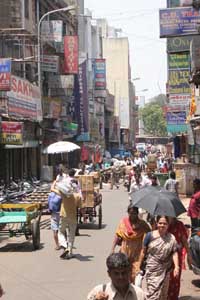|
Yet another election has come and gone with another set of hopefuls having promised a whole host of improvements to the oldest part of the city – George Town. The issues have remained the same for many years – decongestion, better civic amenities, better infrastructure and quality of living. But what most city planners and political hopefuls do not realise is that the solutions that fit newer parts of the city can never work in the Town area. It needs solutions in keeping with its character and the nature of its development and layout.

Congested George Town - in need of a master plan. |
George Town offers several unique elements in its make-up which are worthy of preservation and also presentation to outsiders. There is its quaint architectural mix – part colonial, part art-deco and part traditional. Its segregation of streets by trade is a throwback to an earlier era. Joint-family households with strong traditions are seen more in George Town than in any other area of the city. It has several food outlets which are not only old but, by their specialisation in regional cuisines, also showcase the various parts of India from where people have settled in George Town. Lastly, it has places of worship of all the major religions of India and several of these structures go back three centuries in history and more. If such an area is not worthy of preservation, then what is? Similar old quarters in various other cities of the world have been preserved and celebrated and in time have become tourist attractions. Unfortunately, that has not been the case with George Town.
Firstly, its own residents do not seem aware of the potential that exists in preserving what is left of the old world in this area. Most of the locals look upon their properties only as valuable real estate and do not consider the buildings to be of any use. Demolition goes on all the time with the new replacements being copies of multi-storeyed structures in other parts of the city. Unfortunately for the locals, their streets are simply not designed to cater to buildings of three floors and more and such constructions have an adverse impact on the entire area in terms of ventilation, road space and natural light.
Reinforced concrete is simply not a solution in an area as congested as George Town. While the earlier buildings were meant to reduce heat, the new ones simply radiate it, adding to the ambient temperature. This necessitates airconditioning which in turn takes up further space and also creates problems of water seepage and leaks.
If there is anything worse than what is happening to the architecture, it is the electrification of the area. Most buildings are simply connected to junction boxes by external wires and these are not only ugly, they also pose an enormous threat to anyone who walks by or lives in the vicinity. It is a pity that underground ducting, which has been introduced with much fanfare in the rest of city, has not even been thought of in George Town, the area which needs it most.
Utilisation of road space is yet another challenge in this area. There is always tall talk about the eviction of hawkers from Town, but what is not realised is that they are an integral part of the fabric here. A far better solution would be to regulate traffic into Town, which has simply not been thought of. Taking the example of cities such as Verona in Italy or Jeddah in Saudi Arabia, it would be far better to explore the possibility of making major sections of George Town ‘pedestrians only’, with access only for rickshaws or two-wheelers for most of the day. Heavy vehicle traffic, which is a must for loading and unloading goods traded in the area, needs to be restricted to late night hours. This is currently not the practice. Also, the movement of four-wheelers needs to be controlled as has been done in many other cities of the world. Residents can be convinced to move vehicle parking to areas a short distance away. It is after all not necessary to have a car parked right at one’s doorstep. Even in cities like London this concept has been introduced and, perhaps, it is time to take a leaf from that metropolis’ book and charge exorbitant parking fees as a disincentive for taking cars into the George Town area.
Much has been said about the lack of groundwater in George Town. Yet the area possesses at least five tanks, with the Krishnappa Naicken Tank being a particularly large one. If only the same effort that has been made in Mylapore were to be repeated in Town, the area would see recharging of ground-water. Yet this has not been done and whatever water is left in the tanks is moss-covered and extremely dirty.
All these are simple solutions, but, very importantly, require joint efforts by the government agencies and the public. How can more amenities make sense when what is available is being neglected or not maintained properly? Can we have a separate think-tank on George Town which comes up with a master plan for this area alone? Will it be too much to expect?
|